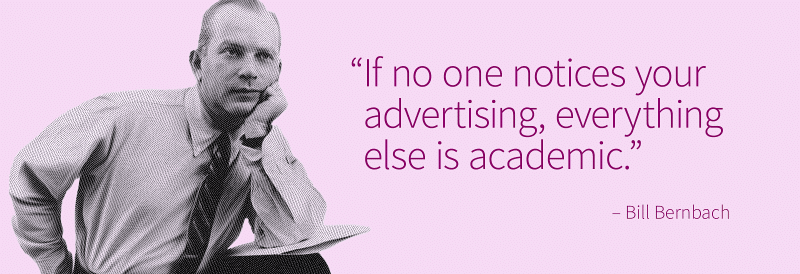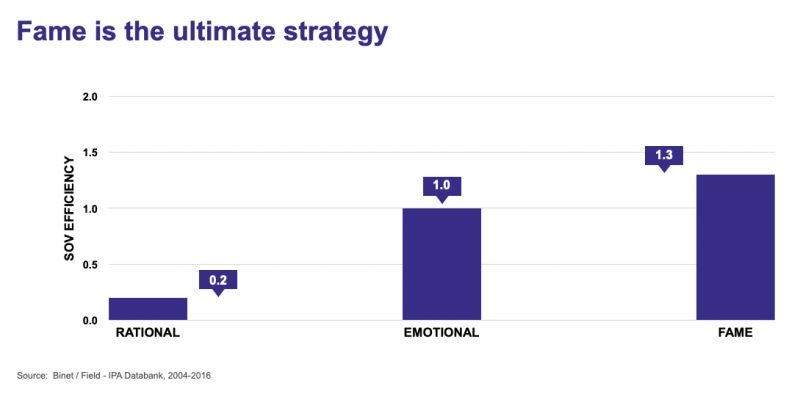
Folks, the data is in, and it turns out the undisputed key to rapid growth and outsized advertising performance is Fame.

Hence the Advertising Effectiveness Mantra: “Aim For Fame”
Note also that Emotional Campaigns outperform rational campaigns by 5X.
So a campaign that causes audiences to bond with your brand is, on average, significantly more likely to deliver increased market share than a campaign based upon rational, reason-why differentiation.
And, yet, a campaign that creates fame is 30% more effective than an emotional campaign.
So how does that work? How do you make your brand famous?
First, let’s look at the chart a bit more closely.
What exactly Is “SOV Efficiency”?
SOV stands for Share of Voice. And Share of Voice Efficiency is based on the understanding that growth requires Excess Share of Voice (or ESOV).
As in, a Share of Voice in Excess to your current Share of Market.
So if you advertise with greater volume relative to your size and your competitors, that excess should power growth, in and of itself.
How much growth depends on the power of your ads and the effectiveness of your media buy.
Meaning they have a high “SOV Efficiency.”
But ads that generate FAME go one better than that.
Those ads tend to have schtick that sticks. They’re memorable, ear-wormy, and repeatable.
But also, they’re widely seen, heard, and noticed.
Granted, impact matters. But the other part that matters is media dominance.
Media Dominance and Fame
Media dominance means showing up in the places you strategically choose to show up.
So if you can’t dominate all media, choose one or two that you can dominate.
If you can’t totally dominate one medium, dominate a given station, day part, zip code, etc.
In other words, make your ads impossible to ignore for some segment of the population.
And, if necessary, shrink your audience until you can swing the media budget required to make “impossible to ignore” a reality.
Here’s an example of that from the legendary Dave Trott:
“Years ago, David Putnam says he learned this when he was an account-man at Collett Dickenson Pearce.
Clients everywhere were running quarter-page ads every week.
John Pearce made his clients put the money into running a single whole-page ad once a month for the same cost, no one else was doing it.
Putnam said the move made CDP’s clients dominate their markets.
No one noticed the weeks when they didn’t run quarter-page ads, but EVERYONE noticed the week when they did run a whole-page ad.
So although they ran fewer ads each ad was many times more effective.”
Now, this is an example of sacrificing some frequency to increase impact, but it’s still a matter of achieving dominance in your media position so that your ads actually “show up” to your audience.
Quarter-page ads are ignorable. So are boring full-page ads.
But great full-page ads show up. And with CDP creating the ads, you better bet they were great.
With broadcast ads, dominance is usually tied to frequency and prominent placement, rather than length, though there is an argument to be made for 60s over 30s.
Why You’re Not Showing Up As Well As You Should Be
So if you feel like your ads aren’t gaining traction, there’s usually one of three reasons:
- Your ads aren’t emotionally compelling or high impact enough
- Your media buy hasn’t generated sufficient ESOV to power growth and/or it’s spread too thin to achieve dominance
- Your campaign lacks schtick that sticks
Want help addressing any or all of those issues? Contact me to set up a free 90-minute session.
- Getting a Foot in the Door — Of Perception - November 27, 2025
- What Digital Superstars Know About Offline Advertising - November 17, 2025
- Unmistakable: A Tale of Two Boots and Branding Done Right - November 8, 2025
